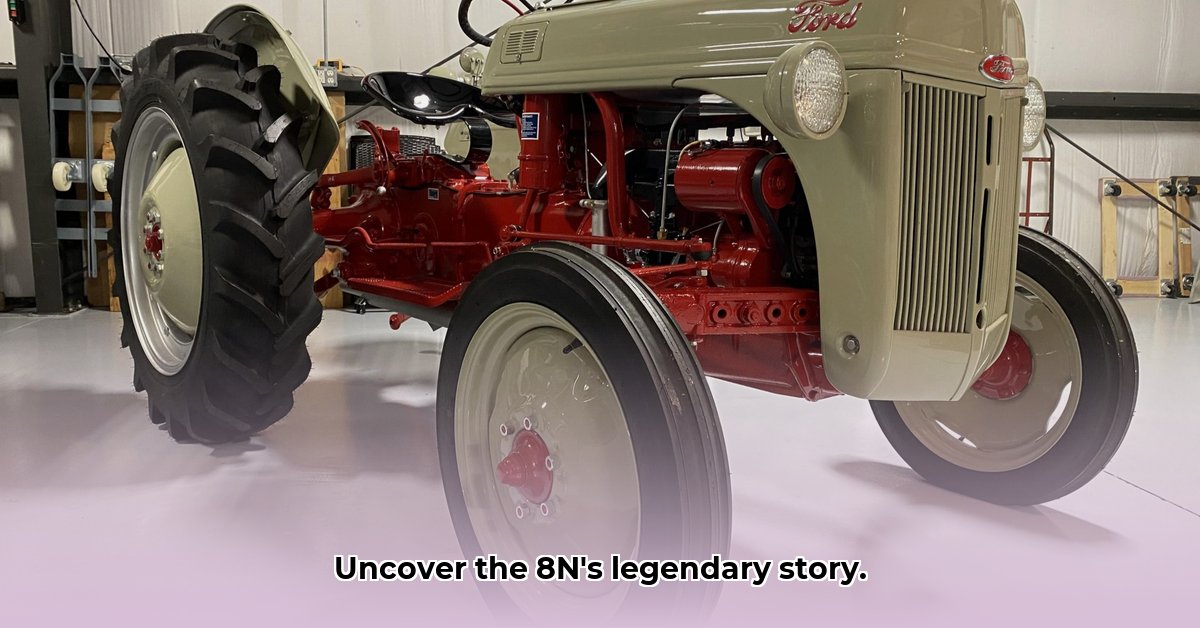
The Ford 8N tractor: a name synonymous with post-war agricultural innovation and enduring legacy. This iconic machine, produced from 1947 to 1952, revolutionized farming for a generation, selling over half a million units. But what made the 1950 Ford 8N so special? This article explores its history, technical specifications, impact on agriculture, and lasting appeal. For more information on Ford tractors of this era, check out this helpful resource: Ford Tractor History.
A Post-War Workhorse: The Rise of the 8N
Emerging from the ashes of World War II, the Ford 8N met a critical need. American farmers, eager to modernize but often constrained by limited resources, found in the 8N a reasonably priced, reliable, and powerful workhorse. Its relatively simple design and straightforward operation made it accessible to a broad range of farmers, contributing to its immense popularity. Why did this tractor become so ubiquitous? Its affordability and ease of use were key factors setting it apart from competitors.
Under the Hood: Power and Practicality
The Ford 8N's engine, a four-cylinder gasoline unit displacing 120 cubic inches, delivered approximately 20 to 30 horsepower (depending on the measurement method used). While not the most powerful tractor available, this output was sufficient for a wide array of farm tasks, including plowing, cultivating, and hauling. A ten-gallon fuel tank provided ample capacity for a long day's work. Its five-gallon hydraulic system offered an impressive lifting capacity of 800 pounds—a significant enhancement over older methods. The 6-volt electrical system was simple and reliable, reflecting the technological standards of the time. While lacking modern amenities like a climate-controlled cabin, its open design contributed to its robust and easily maintained nature. Did the 8N's relatively low horsepower limit its capabilities? Surprisingly, no, considering the typical workload of the time.
A Day in the Fields: Efficiency and Maneuverability
Operating a 1950 8N was a visceral experience. The operator sat directly on the tractor's frame, feeling every bump and vibration. Yet, the tractor's innovative three-point hitch system streamlined implement attachment and detachment, drastically improving efficiency. This simple, yet revolutionary, feature saved farmers valuable time and labor. Moreover, the 8N's surprising maneuverability proved advantageous in smaller fields and confined spaces, making it a versatile machine for farms of varying sizes. How significant was this three-point hitch system? It's considered one of the tractor's most important contributions to ease of use and efficiency.
Shaping Agriculture: A Lasting Impact
The Ford 8N's impact on agriculture extended beyond its immediate functionality. It represented a critical step in the mechanization of American farming, increasing production and reducing the physical demands on farmers. It wasn't just about producing more; it was about making farming less labor-intensive. How profound was this influence? The 8N's widespread adoption helped usher in a new era of agricultural efficiency.
The Collector's Craze: Preserving History
Today, restored 1950 Ford 8N tractors are highly prized by collectors. The process of restoring an 8N is a labor of love, requiring significant time, skill, and often a dedicated search for hard-to-find parts. But this commitment underscores the tractor's lasting appeal—it's a living piece of agricultural history, embodying a simpler time while simultaneously representing an era of incredible technological advancement. Why do people invest so much time and effort in restoring these tractors? For many, it's a nostalgic connection to the past and a testament to sturdy engineering.
Key Specifications:
| Feature | Specification |
|---|---|
| Engine | Four-cylinder, 120 cubic inches |
| Horsepower | Approximately 20-30 hp |
| Fuel Capacity | 10 gallons |
| Hydraulic Fluid | 5 gallons |
| Lift Capacity | 800 lbs |
| Electrical System | 6-volt |
The 1950 Ford 8N remains a testament to simple, robust design and enduring impact. Its legacy continues to inspire both practical farmers and passionate collectors alike. Its enduring popularity serves as a powerful reminder of its significant contribution to the mechanization of American agriculture.